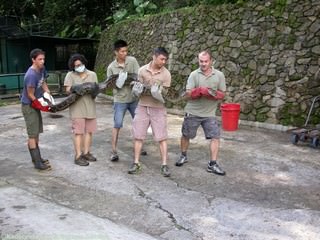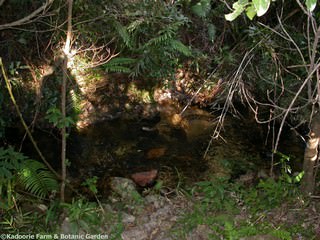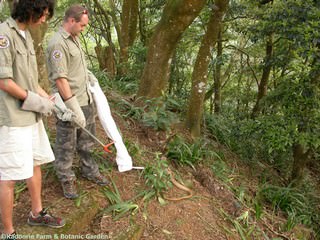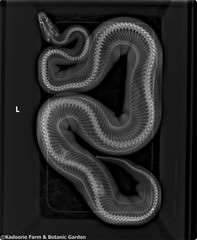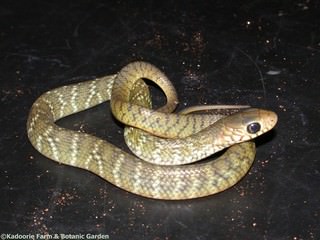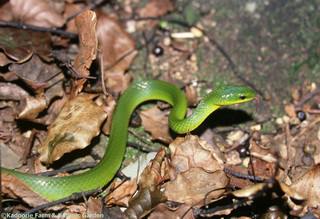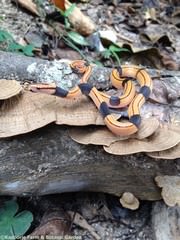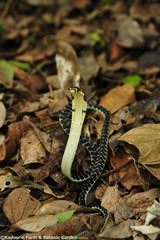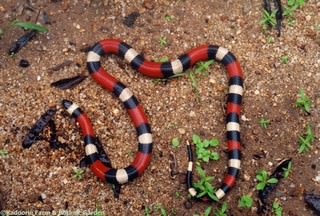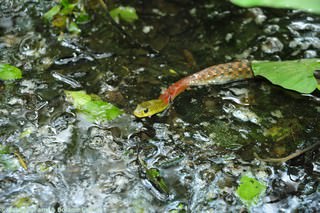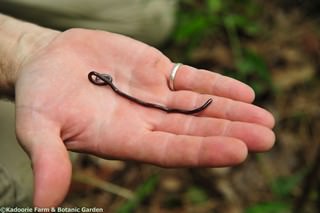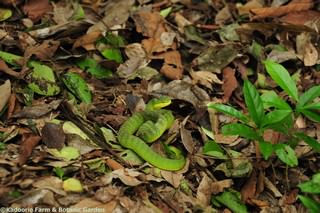HUMAN – SNAKE CONFLICT MITIGATION – a service to wild snakes and the community
In 1999 Kadoorie Farm & Botanic Garden (KFBG) commenced a snake rescue project in partnership with the Agriculture, Fisheries & Conservation Department (AFCD) and the HKSAR Police. This ongoing project helps in the mitigation of human-snake conflicts in Hong Kong.
Since the beginning of the project the rescue professionals at the Wild Animal Rescue Centre of KFBG have received nearly 8,000 snakes. These were mostly received from the Police following capture by a local ‘seh wong’ (snake catcher) and subsequently delivered to KFBG in a specially designed transport and holding box and bag, to ensure staff safety and the wellbeing of the rescued snakes.
Health checks were made on all snakes soon after their arrival at KFBG, to discover whether any injuries were sustained before or during capture that needed attention. Most of the snakes were found to be healthy and were released back to the wild in Country Parks, and other wilderness areas, away from human habitation soon after being received, so as to minimize their stress.
|
Burmese Python prior to health check and measurements - Non-Venomous |
A Burmese Python rests in a Country Park stream following release |
|
Harmless Copper headed Racer released in the Country Park - Non-Venomous |
Python X-rayed during its health check |
Snakes perform important predatory functions in the complex web of nature, controlling pest rodents and even eating other snakes. They themselves are predated by birds of prey and other carnivores, thus providing those animals with food. To maintain a balanced and healthy eco-system it is important that a re-release programme exists. We are fortunate in HK to have several ‘regionally-threatened’ snakes among the 53 local species, and the release of rare species is an important step in conserving the wild populations.
Although we recognize that not all snakes will necessarily survive after being relocated, there is sparse conclusive evidence to suggest that the wide range of species we deal with will not survive. So we would prefer to give the snakes their chance of life, to which they have a right, rather than revert to the previous practice that resulted in all captured individuals being sent into the food trade. We would also prefer to avoid an alternative approach that might see hundreds of healthy snakes each year being unnecessarily destroyed.
|
Common Rat Snake commonly received by the conflict mitigation project - Non-Venomous |
Greater Green Snake a harmless worm-eating snake - Non-Venomous |
|
Red Mountain Racer a rare species which occasionally gets delivered by the HKPolice - Non-Venomous |
A juvenile King Cobra a rare but beautiful rescue case - Venomous |
Scientists can monitor the survival of snakes and other animals through radio-tracking studies, which help to show what the animal does after being released and whether it feeds and survives. There is still plenty of room for more of these studies in HK as there are many gaps in knowledge that need to be filled. We encourage such studies and when opportunities become available we have and will continue to collaborate with the AFCD and local Universities in order to build up more knowledge related to local biodiversity that may help guide us in developing the rescue release process further.
KFBG carried out a post-release snake study, in collaboration with the AFCD, in 2014. This involved the post-release monitoring of 3 Burmese Pythons. Two of the three relocated pythons survived during the entire term of study which was 6 months and, because of this, we expect they are still alive today. The survivors adopted home ranges in their release areas that were between 0.60 Km² and 0.99 Km² and neither moved further than 1.4 Km from the translocated release site.
In 2012 KFBG collaborated with a Hong Kong University study of the post-release monitoring of the Bamboo Pit Viper. This study suggests that adult Bamboo Pit Vipers do not do well when released in new sites.
Both studies included fairly small sample sizes but at least suggested that different species of snakes may adapt very differently once relocated. More studies are needed.
We also receive many exotic (not native to HK) species, which are most likely escaped pets or smuggled snakes. If such a snake is healthy we will try to rehome it with the assistance of the SPCA and Hong Kong Society of Herpetology Foundation. For venomous exotic species we will generally euthanize the snakes as these can present a serious safety and health risk, they cannot be released in Hong Kong and cannot be repatriated, fortunately numbers in this category are small < 10 a year.
|
A Milk Snake one of the exotic pet trade species commonly received by the project - Non-Venomous |
Red-necked Keelback a widespread species often received by the project - Venomous |
|
Common Blind Snake one of HK's smallest snakes occasionally received by the snake rescue programme - Non-Venomous |
An adult Bamboo Pit Viper which feeds on rats and frogs - Venomous |
You may have heard about the recent case of the Pak Tam Chung Burmese Python that had a notorious history of attacking pet dogs and more recently biting a man on the leg as he was walking his dog in the Country Park. This 4.3m female python was captured by a local snake handler and passed to KFBG while its future fate was considered by the AFCD. On arrival at KFBG the snake experts, including KFBG’s Wild Animal Veterinarian were concerned about the elderly female snake’s emaciated appearance and weak condition. Our Veterinarian undertook some blood tests to determine her condition. In the meantime a decision had been made not to release her back to the wild, in the public interest, because of her history of conflict with humans and pet dogs. Also we were considering keeping her as a long term captive animal in an existing snake enclosure. Here we could have shared her story with our education programme visitors. Unfortunately, the health-check results indicated that she was suffering from a serious kidney condition which was not reversible. We conducted a second health check to confirm the results. This condition may have been age-related and also might have accounted for her repeat ambush behavior from the side of a public path. Sitting waiting for dogs would have required less energy and she may have modified her behaviour to take advantage of this feeding strategy. We believe that her condition may have prevented her from carrying out normal hunting behaviour which would have been more energy demanding (natural prey that pythons hunt in the wild includes wild boar and barking deer). We feel that it is possible that she mistook the man’s leg for a dog as he may have had his dog’s scent on his leg. Burmese Pythons very rarely attack people and they would normally not waste time trying to constrict an animal that would be too big to swallow.
Based on over twenty years of experience of treating wild animals we believed that the serious, irreversible kidney condition was causing her suffering. KFBG’s trained experts made the decision to euthanize her on welfare grounds. This action was proposed to AFCD and AFCD duly supported it.
The wildlife care team at KFBG will continue to play their role in conserving the local snakes and work with AFCD and the HK Police in mitigating this human – snake conflict. We would prefer that snakes were left alone and not removed from the wild unless it is necessary for safety. Clearly better education of citizens living in and using Hong Kong’s rural areas might help to prevent some of the ‘emergency’ calls that result in the police delivering small harmless species that could have been left alone.
However, the collaboration of the AFCD, the Police and KFBG has successfully resolved many cases where the public faced a serious safety risk, such as venomous cobras in gardens or houses. Those cobras are not euthanized, they are released far from human activity as are healthy Burmese pythons.
We will keep looking for opportunities to collaborate with local and overseas Universities regarding snake relocation studies and encourage local students to pursue these research topics, which will also help to guide such project work. We also continue to provide a 24-hour service for the Hospital Authority doctors regarding the identification of snakes for snake bite victim treatment cases.
_________________________________________________________________
If you need advice regarding snake issues or would like to have a close encounter experience with a real live, non-venomous snake you can contact fauna@kfbg.org or 2483 7200 for further information.
And some advice
- Think twice before calling 999 to deal with snake conflict issues. Is the snake really causing a threat?
- If you back off, wait a while and give the snake space it may solve the immediate conflict itself by moving away
- Please do not attack any snake - this may cause the snake to instinctively defend itself
For a photo directory of Hong Kong’s snakes please click here.
“LET’S TRY TO LIVE IN HARMONY WITH NATURE AND ENJOY SPECIAL MOMENTS AND ENCOUNTERS WITH WILDLIFE”
Dr. Gary Ades
Head of the Fauna Conservation Department, KFBG


